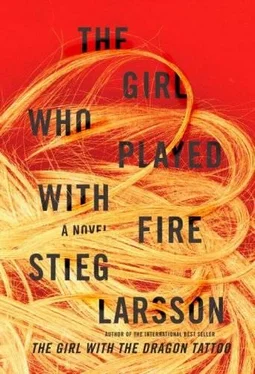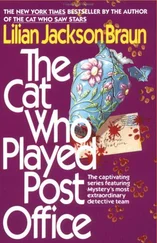“Makes sense to me.”
“If we look at the sketch of the apartment… from what we could reconstruct, we think that the man, Svensson, was shot at close range – possibly point-blank. There are burn marks around the entry wound. We’re guessing that he was shot first. He was thrown against the dining table. The gunman could have stood in the hall or just inside the doorway to the living room.
“According to witnesses, people who live on the same staircase, the shots were fired within a few seconds of each other. Mia Johansson was shot from a greater distance. She was probably standing in the entrance to the bedroom and tried to turn away. The bullet hit her below the left ear and exited just above the right eye. The impact threw her into the bedroom, where she was found. She hit the foot of the bed and slid to the floor.”
“A single shot fired by someone used to handling guns,” Faste said.
“More than that: there were no footprints to indicate that the killer went into the bedroom to check that she was dead. He knew he had hit his mark and he left the apartment. So, two shots, two bodies, and then out. We’ll have to wait for forensics, but I’m guessing that the killer used hunting ammunition. Death would have been instantaneous. There were ghastly wounds in both victims.”
The team considered this summary in silence. It was a debate that none of them needed to be reminded of. There are two types of ammunition: hard, full-metal-jacketed bullets that go straight through the body and cause comparatively modest damage, and soft ammunition that expands in the body on impact and does enormous damage. There is a vast difference between hitting a person with a bullet that’s nine millimetres in diameter and a bullet that expands to a couple of centimetres or more in diameter. The latter type is called hunting ammunition, and its objective is to cause massive bleeding. It is considered more humane when hunting moose, since the aim is to put down the prey as quickly and painlessly as possible. But hunting ammunition is forbidden for use in war by international law, because a soldier hit by an expanding bullet almost always dies, no matter where the point of entry.
In its wisdom, however, the Swedish police had introduced hollow-body hunting ammunition to the police arsenal two years earlier. Exactly why was unclear, but it was quite clear that if, for example, the demonstrator Hannes Westberg, who was hit in the stomach during the World Trade Organization riots in Göteborg in 2001, had been shot with hunting ammo, he would not have survived.
“So the purpose, unquestionably, was to kill,” Andersson said.
He was speaking of the murders in Enskede, but he was also voicing his opinion in the silent debate going on around the table.
Nyberg and Mårtensson agreed.
“Then we have this improbable time frame,” Bublanski said.
“Exactly. Immediately after the fatal shots were fired, the killer leaves the apartment, goes down the stairs, drops the weapon, and vanishes into the night. Shortly thereafter – it can only have been a matter of seconds – Blomkvist and his sister drive up and park outside. One possibility is that the killer left through the basement. There’s a side entrance he could have used – into the back courtyard and across a lawn to the street that runs parallel. But he would have had to have a key to the basement door.”
“Is there any sign at all that the killer left that way?”
“No.”
“So, no description to go on,” Modig said. “But why did he ditch the weapon? If he had taken it with him – or if he had flung it away some distance from the building – we wouldn’t have found it for a while.”
It was a question that no-one could answer.
“What should we think about Blomkvist?” Faste said.
“No question he was in shock,” Mårtensson said. “But he acted sensibly. He seemed clearheaded, and I thought he was trustworthy. His sister, a lawyer, confirmed the phone call and the drive there by car. I don’t think he was involved.”
“He’s a celebrity journalist,” Modig said.
“So this is going to turn into a media circus,” Bublanski said. “All the more reason to wrap it up as fast as we can. OK… Jerker, you’ll deal with the crime scene, of course, and the neighbours. Faste, you and Curt investigate the victims. Who were they, what were they working on, who was in their circle of friends, who might have had a motive to kill them? Sonja, you and I will go over the witness statements from that night. Then you’ll make a schedule of what Svensson and Johansson were doing all day yesterday before they were killed. We’ll meet here at 2:00 this afternoon.”
Blomkvist began his working day at Svensson’s desk. He sat quite still for a long while, as if he did not feel up to taking on the task.
Svensson had his own laptop and had initially worked mostly from home. He had usually spent two days a week in the office; more in the last weeks. At Millennium he had access to an older PowerMac G3, a computer that lived on his desk and could be used by any of the staff. Blomkvist turned on the G3 and found much of the material Svensson had been working on. He had primarily used the G3 to search the Net, but there were various folders that he had copied over from his laptop. He also had a complete backup on two disks that he kept locked in the desk drawer. Usually he had backed up new and updated material every day, but since he had not been in the office for a few days, the latest copy was from Sunday night. Three days were missing.
Blomkvist made a copy of the Zip disk and locked it in the safe in his office. Then he spent forty-five minutes going through the contents of the original disk. It contained around thirty folders and countless sub-folders. Four years of Svensson’s research on trafficking. He read the document names and looked for ones that might contain the most sensitive material – the names of sources that Svensson was protecting. He had clearly been very careful with his sources – all such material was in a folder labelled. The folder contained 134 documents, most of them quite small. Blomkvist highlighted all the documents and deleted them. He dragged them to an icon for the Burn programme, which did not simply delete the documents but eradicated them byte by byte.
Then he tackled Svensson’s email. He had been given his own email address at Millennium , which he used both at the office and on his laptop. He had his own password, but that did not present a problem, since Blomkvist had administrator rights and was able to access the entire mail server. He downloaded a copy of Svensson’s email and burned it to a CD.
Finally he turned his attention to the mountain of paper made up of reference material, notes, press clippings, court judgments, and all the correspondence that Svensson had accumulated. He played it safe and made copies of everything that looked important. That came to two thousand pages and took him three hours.
He set to one side all the material that might in any way be connected to a confidential source. It was a stack of about forty pages, mainly notes from two A4 pads that Svensson had locked in his desk. Blomkvist put this material in an envelope and took it into his office. Then he carried all the other material that was part of Svensson’s project to his desk.
When he was finished he took a deep breath and went down to the 7-Eleven, where he had a coffee and a slice of pizza. He mistakenly assumed that the police would arrive at any moment to go through Svensson’s desk.
Bublanski had an unexpected breakthrough in the investigation just after 10:00 a.m., when he was called by Lennart Granlund of the National Forensics Laboratory in Linköping:
“It’s about the killings in Enskede.”
Читать дальше












